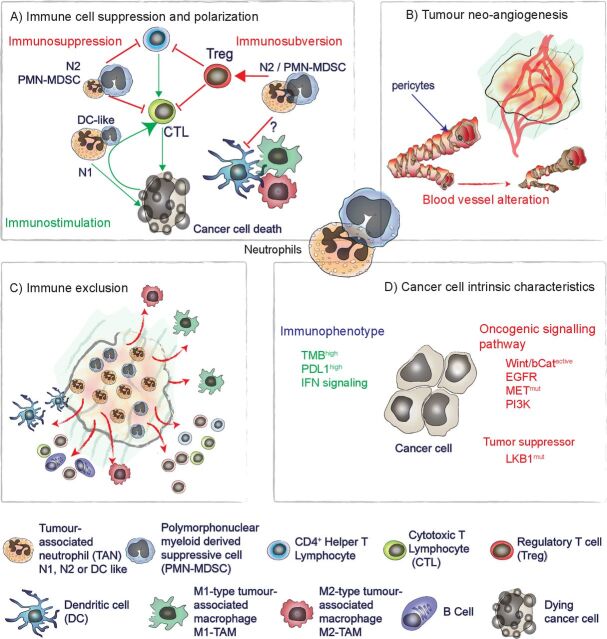Figure 1.
Specific TAN effects and related tumor characteristics linking neutrophil with ICI response. We identified four key features of the response to ICIs that are linked to neutrophil infiltration. (A) Immune cell suppression and polarization: TAN can inhibit T-cell functions in vitro and in vivo, favoring the recruitment of immunosuppressive Treg and altering dendritic cell and macrophage functions. (B) Tumor neoangiogenesis: neutrophils are associated with different tumor neoangiogenesis mechanisms and resistance to anti-VEGF antibody treatment in various preclinical settings. (C) Immune exclusion: neutrophil accumulation in the tumor mass is associated with reduced tumor infiltration by adaptive immune cells and macrophages, limiting ICI efficacy in various models. (D) Cancer cell intrinsic characteristics: strong TMB, expression of PD-L1 and integrity of IFN signaling are associated with a better response to ICIs. Conversely, mutations leading to hyperactivation of the Wnt/β-cat, EGFR, MET, and PI3K signaling pathways are associated with ICI resistance. MET and PI3K signaling alterations and loss of LKB1 have been associated with increased tumor-promoting neutrophil recruitment. (A, C) Can be seen as TAN-specific effect affecting ICI response while (B, D) are characteristics known to be linked with ICI response and related to TAN infiltration and tumor-promoting effect. EGFR, endothelial growth factor receptor; ICI, immune checkpoint inhibitor; IFN, interferon; PD-L1, programmed cell death ligand-1; PI3K, phosphatidylinositol-3-kinase; TMB, tumor mutational burden; Treg, regulatory T cell; VEGF, vascular endothelial growth factor.

